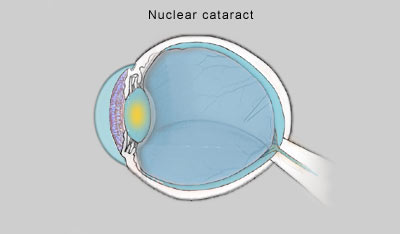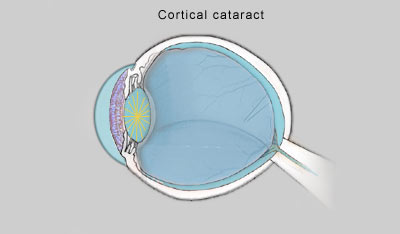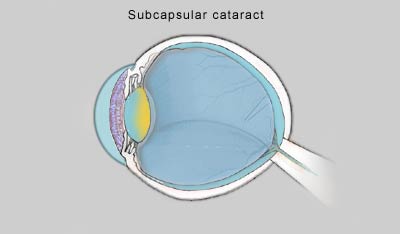Overview
A cataract is a clouding of the eye's normally clear
lens, leading to a progressive blurring or dimming of
vision. It is the world’s leading cause of blindness and
among the most common conditions related to aging – by
age 65, you have a 50 percent chance of developing a
cataract and by age 75, it jumps to 70 percent.
Cataracts can also result from injury, chronic eye
diseases such as retinitis pigmentosa and ailments such
as diabetes, or past use of corticosteroid medications
or radiation treatments. Some researchers believe that
lifestyle habits such as smoking and not wearing
sunglasses to protect eyes against ultraviolet light are
also risk factors.
A cataract occurs when proteins in the lens begin to
clump together, forming a cloudy area. As these clumps
grow, they interfere with vision by distorting or
blocking the passage of light. Many cataracts begin to
form in your 40s or 50s, but don’t affect vision until
years later. Cataracts can occur in infants, usually the
result of an infection during pregnancy such as
toxoplasmosis, rubella, syphilis or herpes simplex. In
children, a cataract can also result from metabolic
disease.
There are three primary types:
- Nuclear cataracts are the most common,
typically known as “age-related cataract.” Found in
the center of the lens, they intefere with the
ability to see distant objects. Interestingly, while
the cataract is progressing, reading vision may
temporarily improve because as the lens becomes more
dense and cloudy, it changes the eye's ability to
focus, making it clearer up close than at far
distances. This symptom is often referred to as
"second sight."
 |
| A nuclear cataract clouds the lens in
the center. |
- Cortical cataracts begin in the lens's
outer rim and grow "spokes" toward the central core.
These spokes block light, causing glare and loss of
contrast. Both near and distance vision are slowly
disrupted. Diabetics often develop this type of
cataract.
 |
| A cortical cataract develops spokes from
the center of the lens outward.
|
- Subcapsular cataracts affect the back of
your lens and usually progress more quickly than
other types. Subcapsular cataracts cause blurriness
and glare, and are more likely to strike those with
diabetes, extreme nearsightedness, retinitus
pigmentosa or people who take steroid medications.
 |
| A subcapsular cataract builds up on the
back of the lens. |
Symptoms
A cataract starts out small and initially has little or
no effect on vision. As the cataract grows and clouds
more of the lens – what doctors call “ripens" – it will
be harder to read and do other normal tasks. The word
"cataract" means waterfall and for people with a ripe
cataract, it is like trying to see through a waterfall
or wall of fog. Other symptoms include:
- Blurred vision, as if you are looking through a
cloudy piece of glass
- Double vision (diplopia)
- A sense that colors appear faded and decreased
ability to distinguish some colors
- Seeing halos around lights
- Glare or sensitivity to light or from oncoming
headlights while driving
- Difficulty seeing at night
Prevention
There is no way to prevent age-related cataracts, but
several factors can increase your risk of developing
them sooner, or developing other types of cataracts. If
you have diabetes, you need to tightly control your
blood sugar level. Women can reduce risk of congenital
cataracts with rubella immunization before becoming
pregnant and monitoring conditions such as herpes.
Others factors that can play a role in prevention:
- Avoiding eye injuries, such as a blow or other
trauma
- Not smoking
- Limiting or eliminating use of corticosteroids,
major tranquilizers and diuretics
- Protecting eyes with quality sunglasses,
especially if you live at a high altitude or spend a
lot of time outdoors
- Avoiding alcohol abuse
- Eating a healthy diet. Although there is no
definitive proof, some studies suggest that
“antioxidant” nutrients such vitamin C may play a
preventative role.
Treatment
In the early stages until the cataract ripens, your
doctor may recommend stronger eyeglasses, using eye
drops to widen the pupil and let in more light or
adjusting lighting to reduce glare. When cataracts
disrupt your daily life, it may be time for
cataract-removal surgery, one of the most frequent
procedures done in the U.S. If both eyes are affected,
the surgeries are performed on different days.
More than 1.5 million Americans undergo surgery each
year to remove the clouded lens, which is usually
replaced with a clear, plastic intraocular lens (IOL).
With an IOL, vision is restored to 20/40 or better in
more than 90 percent of cases. You cannot see or feel
the lens and it needs no special care. For those unable
to wear an IOL, special glasses with powerful
magnification or contact lenses are used.
Cataract surgery falls into two groups:
- Intracapsular: Both the lens and the
protective capsule that surrounds it are removed.
Once standard, this has been largely replaced by
extracapsular surgery. Those who require
intracapsular surgery may not be eligible for IOLs
and instead need specially designed glasses or
contacts.
- Extracapsular: Only the lens is removed.
The front of the capsule is opened and ultrasonic
waves break the lens into pieces (a process called “phacoemulsification”).
The pieces are then vacuumed out of the capsule. The
normal lens capsule surrounding the lens is left
intact.
|